Introduction
Mycotoxicosis is a significant issue affecting the poultry industry. Aflatoxins are among the most abundant and dangerous groups of mycotoxins, having been detected not only in raw materials and feed but also in surface water, wastewater and drinking water samples (Wang et al., 2023). These mycotoxins are produced by various fungal species of the genus Aspergillus, with A. flavus and A. parasiticus being the most notable. These toxigenic fungi synthesize four main mycotoxins: aflatoxins B1, B2, G1 and G2 (Cáceres et al., 2020).
Specifically, aflatoxin B1 is classified as a Group 1 carcinogen by the World Health Organization (WHO) (Ruan et al., 2023). It is the most commonly monitored and internationally regulated mycotoxin due to its potent carcinogenic and mutagenic effects. However, the fact that other aflatoxins are often not included in analyses may pose an emerging public health problem, as their high toxicity tends to be underestimated (Wang et al., 2023).
Aflatoxins reduce animal performance, as they are associated with decreased feed intake, which leads to growth retardation. This results in up to an 11% reduction in daily weight gain and up to a 9% decrease in the final body weight of broiler chickens (Andretta et al., 2011). In laying hens, aflatoxins lead to decreased egg production and reduced egg size (Raj et al., 2023; Ochieng et al., 2021). Additionally, aflatoxin B1 contamination exacerbates bone-related disorders in poultry production and hampers eggshell formation (Raj et al., 2023; Paneru et al., 2024).
Moreover, the presence of aflatoxin residues in poultry products is a major public health concern, as these compounds enter the human food chain through their accumulation in eggs and poultry meat (Saleemi et al., 2020).
Therefore, the use of effective anti-mycotoxin solutions is essential to maintain performance and profitability in poultry productions. BIŌNTE® QUIMITŌX® PLUS with its three modes of action: adsorption, bioprotection, and post-biotic effect has demonstrated high efficacy against multiple mycotoxins, including aflatoxins, in in vitro studies. In this context, a study was conducted in Brazil, in collaboration with the Federal University of Santa Maria and Samitec Institute, to demonstrate the in vivo efficacy of the product in broiler chickens challenged with aflatoxins.
Experimental design
The objective of the present study was to demonstrate the efficacy of BIŌNTE® QUIMITŌX® PLUS in an in vivo trial conducted on broiler chickens exposed to aflatoxins B1, B2, G1 and G2 through the ingestion of contaminated feed.
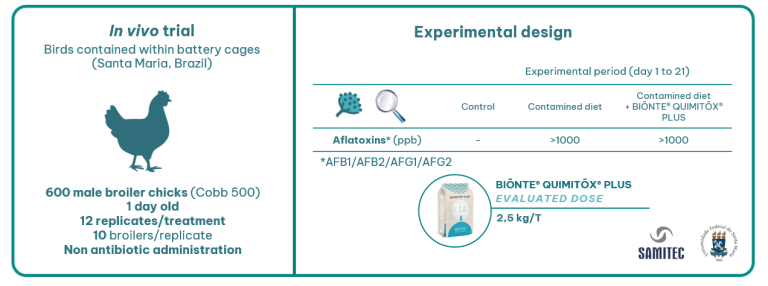
Figure 1. Experimental design.
The experimental design included three groups: one receiving a control diet without mycotoxins; a second group fed a diet contaminated with critical levels of aflatoxins; and a third group fed the contaminated diet supplemented with 2.5 kg/T of BIŌNTE® QUIMITŌX® PLUS.
Throughout the study, body weight and average daily gain of the animals were monitored weekly. At the end of the trial, relative liver weights were recorded, and histopathological analysis was performed on liver and intestinal samples. Additionally, microbiological analysis of the intestinal tract and histopathological examination of the bursa of Fabricius were carried out.
BIŌNTE® QUIMITŌX® PLUS improved the productive parameters of broilers exposed to aflatoxins
The presence of aflatoxins in the feed reduced the body weight of the animals by up to 11.3%. However, by including BIŌNTE® QUIMITŌX® PLUS in the feed, this effect was counteracted, leading to an 8.6% increase in the body weight of the broiler chickens by the end of the study.
On the other hand, the average daily gain of the animals was also affected by the presence of aflatoxins in the feed, resulting in a 15.4% reduction. The administration of BIŌNTE® QUIMITŌX® PLUS successfully recovered up to 6.7% of this parameter.
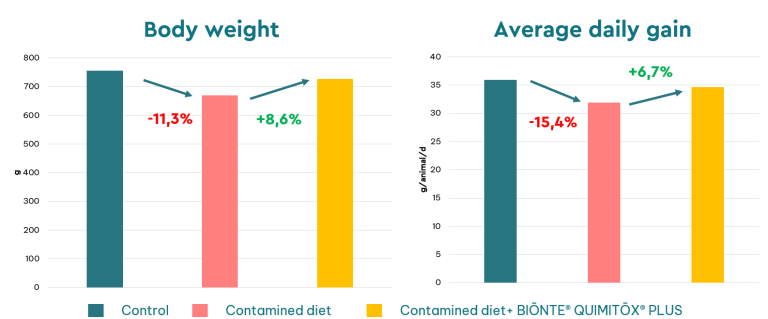
Figure 2. Productive parameters in broilers not exposed to mycotoxins (control), exposed to a diet contaminated with aflatoxins, and exposed to the aflatoxin-contaminated diet with supplementation of BIŌNTE® QUIMITŌX® PLUS.
BIŌNTE® QUIMITŌX® PLUS reduced liver damage caused by aflatoxins in broilers
The relative liver weight of broilers exposed to the contaminated diet significantly increased as a result of the inflammatory pathological effect of these substances. In the animals treated with BIŌNTE® QUIMITŌX® PLUS, a recovery in liver size was achieved, with a reduction of up to 16.8%.
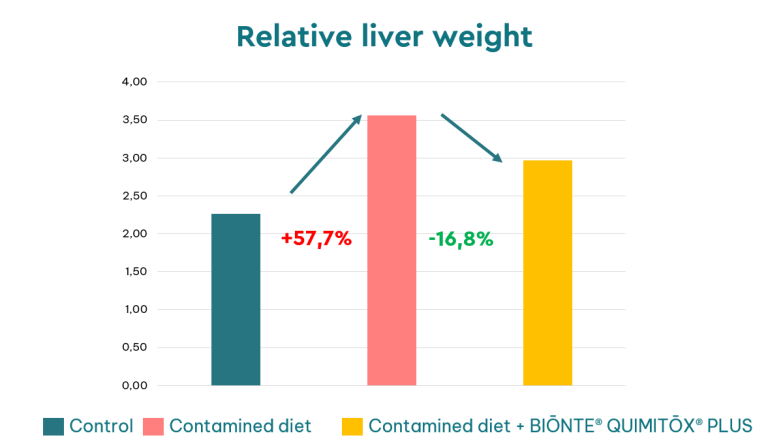
Figure 3. Relative liver weight in broilers not exposed to mycotoxins (control), exposed to a diet contaminated with aflatoxins, and exposed to the aflatoxin-contaminated diet with supplementation of BIŌNTE® QUIMITŌX® PLUS.
Through the histopathological analysis conducted at the hepatic level, lesions such as heterophilic and mononuclear infiltration, as well as hepatocellular degeneration, were detected in animals exposed to aflatoxins. In contrast, in the study of animals that received treatment with BIŌNTE® QUIMITŌX® PLUS, these lesions were counteracted, with no infiltration or degeneration observed.
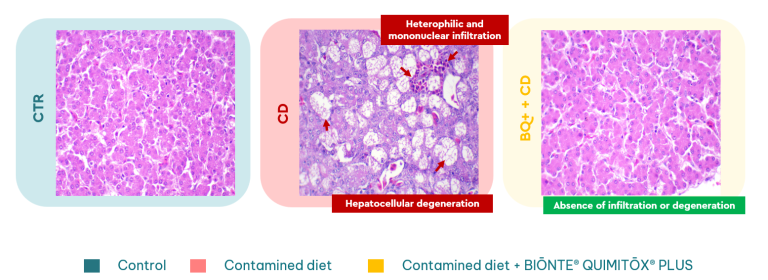
Figure 4. Histopathological images of the liver in broilers not exposed to mycotoxins (control), exposed to a diet contaminated with aflatoxins, and exposed to the aflatoxin-contaminated diet with supplementation of BIŌNTE® QUIMITŌX® PLUS.
BIŌNTE® QUIMITŌX® PLUS counteracted the intestinal damage caused in broilers exposed to aflatoxins.
The intestinal histopathological analysis revealed that exposure to aflatoxins reduced the height of the intestinal villi (VH), as well as increased the depth of the crypts (CD). The absorption surface was reduced by 22.2% in broiler chickens exposed to the contaminated diet.

Figure 5. Histopathological results of the jejunum in broilers not exposed to mycotoxins (control), exposed to a diet contaminated with aflatoxins, and exposed to the aflatoxin-contaminated diet with supplementation of BIŌNTE® QUIMITŌX® PLUS.
By administering BIŌNTE® QUIMITŌX® PLUS, the intestinal damage caused in the animals by aflatoxin exposure was counteracted. As a result, the intestinal absorption surface increased by 17.5%.

Figure 6. Histopathological images of the jejunum in broilers not exposed to mycotoxins (control), exposed to a diet contaminated with aflatoxins, and exposed to the aflatoxin-contaminated diet with supplementation of BIŌNTE® QUIMITŌX® PLUS.
Additionally, the contamination of the feed of broiler chickens with aflatoxins affected the microbiological balance of the gastrointestinal tract, resulting in a reduced bacilli/enterobacteria ratio. BIŌNTE® QUIMITŌX® PLUS restored this balance, improving the ratio by up to 8.6%.
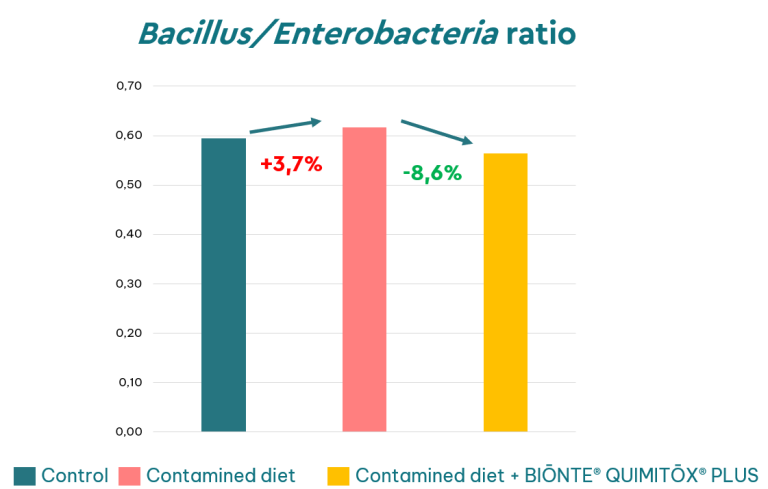
Figure 7. Bacilli/Enterobacteria ratio in the intestinal tract of broilers not exposed to mycotoxins (control), exposed to a diet contaminated with aflatoxins, and exposed to the aflatoxin-contaminated diet with supplementation of BIŌNTE® QUIMITŌX® PLUS.
BIŌNTE® QUIMITŌX® PLUS counteracted the damage caused to the immune system of broilers.
The bursa of Fabricius was another organ in which the pathological effect of mycotoxins in broilers was determined. Aflatoxins caused lesions such as lymphoid depletion, which affected the physiological structure of the organ. In animals that received BIŌNTE® QUIMITŌX® PLUS, this damage was counteracted, and the natural structure of this lymphoid organ was restored, thereby improving its immune function.

Figure 8. Histopathological images of the bursa of Fabricius in broilers not exposed to mycotoxins (control), exposed to a diet contaminated with aflatoxins, and exposed to the aflatoxin-contaminated diet with supplementation of BIŌNTE® QUIMITŌX® PLUS.
Conclusions
Aflatoxins, highly prevalent mycotoxins in raw materials and feed, negatively affect the health of broiler chickens. As a consequence, they worsen their productive parameters and alter the structure of vital organs, severely compromising their health and performance.
Based on this in vivo study, it was demonstrated that the administration of BIŌNTE® QUIMITŌX® PLUS in broilers improved their productive performance, counteracting the damage caused by aflatoxins at the hepatic, intestinal, and bursa of Fabricius levels. The inclusion of the product enhances the health and well-being of the animals, thereby contributing to the improved profitability of poultry productions.


